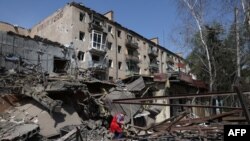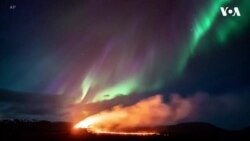ເງິນຈຳນວນ 90 ລ້ານໂດລາ ທີ່ລັດຖະບານທ່ານໂອບາມາ ໄດ້ໃຫ້ ຄວາມໝັ້ນໝາຍ
ເພື່ອຊ່ວຍເຫຼືອລາວກຳຈັດລະເບີດບໍ່ທັນແຕກທີ່ຕົກຄ້າງແຕ່ປາງສົງຄາມຫວຽດນາມ
ແມ່ນພວມມີການເລັ່ງລັດ ແຕ່ວຽກງານດັ່ງກ່າວອາດຈະໃຊ້ ເວລາຕື່ມອີກຢ່າງໜ້ອຍ
ນຶ່ງທົດສະວັດ ຫຼື ຫຼາຍກວ່ານັ້ນ. ນັກຂ່າວວີໂອເອ ມີລາຍງານ ກ່ຽວກັບເລື້ອງນີ້ ຊຶ່ງ
ກິ່ງສະຫວັນ ຈະນຳເອົາລາຍລະອຽດ ມາສະເໜີທ່ານ ໃນອັນດັບຕໍ່ໄປ.
ມັນແມ່ນວັນທີ 2 ມີນາ ປີ 2014 ຊຶ່ງເປັນມື້ທີ່ມີແສງແດດກ້າ ທີ່ນາງບົວຄຳ ຈື່ໄດ້ວ່າ ລູກ
ລະເບີດທີ່ສະຫະລັດຖິ້ມລົງໃສ່ປະເທດລາວໃນສະໄໝດົນກວ່າ 4 ທົດສະວັດແລ້ວນັ້ນ
ໄດ້ເຮັດໃຫ້ຂາຂວາຂອງນາງຂາດອອກເປັນສອງຕ່ອນ.
ນາງແລະລູກຊາຍສອງຄົນ ກຳລັງພາກັນຂວັດເຂ່ຍຂີ້ດິນ ຢູ່ທີ່ທົ່ງນາແຫ່ງນຶ່ງໃກ້ບ້ານ
ຂອງເຂົາເຈົ້າຢູ່ແຂວງຊຽງຂວາງ ໃນພາກເໜືອຂອງລາວ ເພື່ອຊອກຫາລະເບີດລູກ
ຫວ່ານ ທີ່ສະຫະລັດໄດ້ຖິ້ມລົງໃສ່ປະເທດລາວໃນສະໄໝສົງຄາມຫວຽດນາມ. ພວກ
ເຂົາເຈົ້າຫວັງວ່າຈະໄດ້ເຫັນໂລຫະທີ່ມີຄ່າແລະຂາຍໃຫ້ຜູ້ຊາຍຫວຽດນາມ 2 ຄົນ ທີ່ໄປ
ນຳພວກເຂົາເຈົ້ານັ້ນ.
ນາງເລົ່າສູ່ວີໂອເອຟັງວ່າ “ຂ້ອຍເຮັດແນວນີ້ມາໄດ້ 10 ປີແລ້ວ ໄດ້ຊອກທ້ອນເອົາໂລ
ຫະ ເພື່ອຂາຍໃຫ້ຄົນຫວຽດນາມ” ໃນຂະນະທີ່ຍົກມື ທີ່ກຳກ່ຳປັ້ນແບບຫລົມໆຂຶ້ນ
ເພື່ອສະແດງໃຫ້ເຫັນຄືກັນກັບໜ່ວຍລະເບີດ ທີ່ມີຂະໜາດເທົ່າກັນກັບໝາກບານ
ເທັນນິສ.
ແຕ່ວ່າໃນຂະນະທີ່ເອົາລູກລະເບີດ ໃສ່ລົງໄປໃນຖົງຢາງປລາສຕິກມື້ນັ້ນ ກໍມີຜູ້ນຶ່ງໃນນັ້ນ
ໄດ້ຂຸດໄປຖືກລູກລະເບີດອີກໜ່ວຍນຶ່ງ ແລະມັນກໍໄດ້ແຕກໃສ່ໃກ້ຕີນຂອງນາງ. ສະເກັດ
ລູກລະເບີດ ທີ່ຊອດອອກຈາກຂາຂອງນາງ ໄດ້ໄປຖືກໜ້າ ເອິກຂອງລູກຊາຍຄົນນຶ່ ແລະ
ຟົ້ງໃສ່ຕາຂອງລູກຊາຍອີກຄົນນຶ່ງຂອງລາວແລະ ກໍໄດ້ເຮັດໃຫ້ຜູ້ຊາຍຊາວຫວຽດນາມ
ຄົນນຶ່ງເສຍຊີວິດຄາທີ່.
ນາງເວົ້າອີກວ່າ "ຫຼັງຈາກລະເບີດໄດ້ແຕກຂຶ້ນແລ້ວ ຂ້ອຍເຫັນວ່າ ຂາຂອງຂ້ອຍກ້ຳ
ນຶ່ງ ໄດ້ຫາຍໄປແລ້ວ ແລະຂ້ອຍໄດ້ເອີ້ນຫາຜົວຂອງຂ້ອຍ. ສິ່ງທຳອິດຕອນຂ້ອຍຮູ້
ເມື່ອຂຶ້ນມາ ຈື່ໄດ້ວ່າ ແມ່ນຕອນຂ້ອຍນອນຢູ່ໂຮງໝໍ.”
ໃນຕອນທ່ານໄປຢ້ຽມຢາມລາວໃນປີ 2016 ນັ້ນ ທ່ານປະທານາທິບໍດີ ບາຣັກ ໂອບາມາ
ໄດ້ໃຫ້ຄຳໝັ້ນສັນຍາວ່າ ຈະເອົາເງິນໃຫ້ເພີ້ມ 90 ລ້ານໂດລາ ເຂົ້າໃນເງິນ “ພັນທະທາງ
ສິນລະທຳ” ຂອງອາເມຣິກາ ເພື່ອຊ່ວຍເຫລືອລາວກຳຈັດລະເບີດຍັງບໍ່ທັນແຕກ ຊຶ່ງມັກ
ເອີ້ນກັນວ່າ UXO ທີ່ເປັນລະເບີດ ຕົກຄ້າງຈາກລະເບີດ 2 ລ້ານໂຕນ ທີ່ສະຫະລັດໄດ້ຖິ້ມ
ລົງໃສ່ປະເທດລາວ ຊຶ່ງເປັນນ້ອຍໆ ແຕ່ປີ 1964 ຫາ 1973. ເຄິ່ງນຶ່ງຂອງເງິນຈຳນວນ
ດັ່ງກ່າວ ແມ່ນໃຊ້ເພື່ອທຳການສຳຫລວດຢ່າງລະອຽດໃນທົ່ວປະເທດ ເພື່ອຊອກຫາລະ
ເບີດທີ່ບໍ່ທັນແຕກ ຢູ່ໃນລາວແບບທີ່ບໍ່ເຄີຍມີມາກ່ອນ.
ເມື່ອມໍ່ໆມານີ້ ອົງການສະຫະປະຊາຊາດໄດ້ເລື່ອນເວລາອອກໃຫ້ແກ່ລາວຕໍ່ເປົ້າໝາຍປີ
2020 ທີ່ປະເທດດັ່ງກ່າວໄດ້ຕົກລົງໄວ້ ຢູ່ໃນສົນທິສັນຍາ ວ່າດ້ວຍລະເບີດລູກຫວ່ານ ທີ່
ຈະກຳຈັດລະເບີດດັ່ງກ່າວໃຫ້ໝົດ ໂດຍເວລາອອກໄປຮອດປີ 2025. ລັດຖະບານລາວ
ໄດ້ວາງເປົ້າໝາຍຂອງຕົນໃສ່ປີ 2030 ແຕ່ພວກນັກຊ່ຽວຊານບາງຄົນເວົ້າວ່າ ບໍ່ມີໃຜສາ
ມາດເວົ້າໄດ້ວ່າ ວຽກນີ້ຈະໃຊ້ເວລາອີກດົນປານໃດ.
"ມັນເປັນຄຳຖາມທີ່ຄົນມັກຖາມຫລາຍທີ່ສຸດຕໍ່ພວກເຮົາ ທີ່ເວົ້າວ່າປານໃດມັນຈະຖືກ
ກຳຈັດໃຫ້ໝົດໄປ ແຕ່ແນ່ນອນ ມັນຄືກັນກັບຖາມທີ່ວ່າ ເຊືອກເສັ້ນນຶ່ງ ມັນຍາວປານ
ໃດ ແມ່ນບໍ?
ທຸກສິ່ງທຸກຢ່າງ ແມ່ນຂຶ້ນຢູ່ກັບທຶນຮອນ" ນັ້ນຄືຄຳເວົ້າຂອງທ່ານນາງ Sarah Goring
ເຈົ້າໜ້າທີ່ຂອງໂຄງການປະຈຳປະເທດລາວ ຂອງກຸ່ມ Mines Advisory ທີ່ຕັ້ງຢູ່ອັງກິດ
ຊຶ່ງໄດ້ດຳເນີນວຽກງານກຳຈັດລະເບີດ ໃຫຍ່ທີ່ສຸດໃນລາວ ຮອງຈາກອົງການ ຂອງລັດ
ຖະບານລົງມາ.
ອົງການສະຫະປະຊາຊາດໄດ້ເລື່ອນເວລາໃນການຕັ້ງເປົ້າໝາຍໄປໃສ່ປີ 2025 ກໍ
ເພາະວ່າອົງການດັ່ງກ່າວ ສາມາດເລື່ອນເວລາໄດ້ແຕ່ພຽງ 5 ປີເທົ່ານັ້ນ ອີງຕາມທ່ານ
ນາງ Goring.
ໃນການຕາມລ່າກຳລັງທະຫານຫວຽດນາມເໜືອຢູ່ຕາມເສັ້ນທາງໂຮ່ຈິມິນແລະກຳລັງ
ຄອມມູນິສປະເທດລາວ ຊຶ່ງໃນທີ່ສຸດກໍເປັນຝ່າຍຊະນະໃນສົງຄາມກາງເມືອງ ຢູ່ລາວ
ໃນປີ 1975 ນັ້ນ ສະຫະລັດໄດ້ເຮັດໃຫ້ລາວກາຍເປັນປະເທດທີ່ຖືກຖິ້ມ ລະເບີດໃສ່ ໂດຍສະເລ່ຍແລ້ວ ຫຼາຍທີ່ສຸດໃນໂລກ. ອາວຸດທີ່ໃຊ້ກັນຫຼາຍທີ່ສຸດ ແມ່ນລະເບີດລູກ
ຫວ່ານ ຊຶ່ງລະເບີດດັ່ງກ່າວຈະເປີດອ້າອອກຢູ່ກາງອາກາດເພື່ອ ຫວ່ານລູກລະເບີດ
ນ້ອຍຫຼາຍຮ້ອຍໜ່ວຍທີ່ເອີ້ນວ່າ ບອມບີ້ ໃຫ້ກະຈາຍອອກໄປ ຄືກັນກັບທີ່ໄດ້ເຮັດໃຫ້
ນາງບົວຄຳບາດເຈັບ ເມື່ອຫ້າປີກ່ອນນັ້ນ.
ປະມານ 1 ສ່ວນ 3 ຂອງລູກບອມບີ້ ຊຶ່ງທັງໝົດມີຫຼາຍສິບລ້ານໜ່ວຍນັ້ນ ບໍ່ ໄດ້ແຕກ
ເວລາຕົກລົງມາ. ການກະປະມານກ່ຽວກັບວ່າມີດິນດອນຫຼາຍປານໃດປົກຄຸມດ້ວຍລະ
ເບີດດັ່ງກ່າວນີ້ແມ່ນແຕກຕ່າງກັນຢ່າງຫຼວງຫຼາຍ. ລັດຖະບານລາວເວົ້າວ່າ 8,000
ຕາລາງກິໂລແມັດ ແຕ່ກຸ່ມ Mines Advisory ເວົ້າວ່າມີບໍ່ຕ່ຳກວ່າ 2,000 ຕາລາງກິ
ໂລແມັດ.
ທ່ານນາງ Goring ກ່າວວ່າ ຂ້າພະເຈົ້າຄິດວ່າ ໂຕຈິງແລ້ວແມ່ນຢູ່ໃນລະຫວ່າງນັ້ນ
ບໍ່ມີໃຜສາມາດຮູ້ໄດ້ຢ່າງຄັກແນ່.
ການສຳຫຼວດທາງດ້ານເຕັກນິກໃນທົ່ວປະເທດ ທ່ານໂອບາມາໄດ້ໃຫ້ຄຳໝັ້ນສັນຍາ
ໄວ້ວ່າ ເຄິ່ງນຶ່ງຂອງເງິນ 90 ລ້ານໂດລາໃນການຊ່ວຍເຫຼືອໃນປີ 2016 ນັ້ນ ຄວນຈະ
ຊ່ວຍ ໃຫ້ພວກເຂົາເຈົ້າຮູ້ ກ່ຽວກັບເລື້ອງນີ້. ສະຫະລັດໄດ້ແບ່ງປັນເງິນດັ່ງກ່າວ ໃຫ້
ແກ່ຫຼາຍໆອົງການ.
ການສຳຫຼວດ ກ່ຽວກັບເຂດທີ່ໄດ້ຮັບຜົນກະທົບສ່ວນໃຫຍ່ ທີ່ມີຂຶ້ນຢູ່ລາວມາຈົນຮອດ
ປັດຈຸບັນນີ້ ແມ່ນການສຳຫຼວດ ບໍ່ແມ່ນໃນດ້ານເຕັກນິກ ແຕ່ມີຂຶ້ນອີງຕາມລາຍງານ
ອຸບັດຕິເຫດທີ່ເກີດຂຶ້ນ ແລະຕາມຄຳເວົ້າຂອງປະຊາຊົນ ໃນເຂດທ້ອງ ຖິ່ນ. ການຂາດ
ຂໍ້ມູນທີ່ຖືກຕ້ອງແມ່ນຍຳນັ້ນໝາຍຄວາມວ່າ ເວລາແລະເງິນຄຳສ່ວນໃຫຍ່ໄດ້ຖືກນຳໄປ
ໃຊ້ໃນການເກັບກູ້ລະເບີດ ໃນເຂດທີ່ກາຍເປັນວ່າ ມີລະເບີດບໍ່ຫຼາຍ ຫຼືວ່າບໍ່ມີຊ້ຳ.
ດ້ວຍການສຳຫຼວດ ທາງດ້ານເຕັກນິກນີ້ ທີມງານຕ້ອງໃຫ້ການຢືນຢັນ ກ່ຽວກັບ ການ
ມີລະເບີດຕົກຄ້າງໃນການສຳຫຼວດຂັ້ນຕົ້ນຄືມີການກວດກາເບິ່ງບ່ອນທີ່ຕ້ອງສົງໄສ ກ່ອນທີ່ຈະລົງມືເກັບກູ້ຢ່າງແທ້ຈິງ. ກຸ່ມ Mines Advisory ແລະອື່ນໆໄດ້ເຮັດການສຳ
ຫຼວດທາງດ້ານເຕັກນິກຢູ່ລາວກ່ອນປີ 2016 ແຕ່ເງິນຊ່ວຍເຫຼືອຂອງສະຫະລັດໃນປີ
ນັ້ນ ໄດ້ຊ່ວຍເຮັດໃຫ້ວຽກງານດັ່ງກ່າວໄວຂຶ້ນ.
ທ່ານ Perparim Elezi ຜູ້ຈັດການສະໜາມທາງດ້ານເຕັກນິກຂອງກຸ່ມ Mines
Advisory ໃນແຂວງຊຽງຂວາງ ກ່າວກ່ຽວກັບການສໍາຫຼວດ ທາງດ້ານເຕັກນິກ ວ່າ ມັນຊ່ວຍກໍຍ້ອນວ່າ ມັນເຮັດໃຫ້ຂັ້ນຕອນໄວຂຶ້ນ. ພວກເຮົາຮູ້ຢ່າງຄັກແນ່ວ່າ ບ່ອນໃດ
ມີລະເບີດຕົກຄ້າງ ແລະບ່ອນໃດບໍ່ມີລະເບີດຕົກຄ້າງ.
ທ່ານ Elezi ຊຶ່ງເປັນອະດີດທະຫານ ຈາກໂກໂຊໂວ ທີ່ມີປະສົບພະການ 20 ກວ່າປີ
ໃນການເກັບກູ້ລະເບີດແລະ UXO ກ່າວວ່າ ການສຳຫຼວດທາງດ້ານເຕັກນິກ ໃນທົ່ວ
ປະເທດລາວສາມາດແລ້ວສຳເລັດ ໃນປີ 2025. ແຕ່ທ່ານກໍເຫັນວ່າມີໂອກາດໜ້ອຍ
ທີ່ສຸດ ທີ່ລາວຈະສາມາດກຳຈັດລະເບີດທີ່ຍັງຕົກຄ້າງໃຫ້ໝົດໄປໄດ້ພາຍໃນເວລານັ້ນ
ແລະກ່າວວ່າ ປີ 2030 ກໍເບິ່ງຄືວ່າ ຍັງເປັນການເດົາສຸ່ມ ຢູ່ ແຕ່ທ່ານກໍກ່າວຕື່ມວ່າ ບໍ່ຄວນເວົ້າວ່າ ມັນເປັນໄປບໍ່ໄດ້ເລີຍ.
ມາຮອດເດືອນກໍລະກົດປີນີ້ ລັດຖະບານ ແລະກຸ່ມສັນຍາຈ້າງຕ່າງໆ ໄດ້ເກັບກູ້ ລະເບີດ
ບໍ່ທັນແຕກອອກຈາກພື້ນທີ່ທັງໝົດ 600 ຕາລາງກິໂລແມັດ ນັບແຕ່ປີ1996 ເປັນຕົ້ນ
ມາເວລາການຈົດບັນທຶກຂອງທາງການເລີ້ມຂຶ້ນ ມີພຽງແຕ່ປະມານ 1 ສ່ວນ 3 ເທົ່າ
ນັ້ນ ທີ່ກຸ່ມ Mines Advisory ກະປະມານແບບຕໍ່າສຸດ ວ່າ ເປັນເຂດທີ່ໄດ້ຜົນກະທົບ ຈາກລະເບີດສະຫະລັດຕົກຄ້າງ.
ວຽກງານການເກັບກູ້ ພວມມີການເລັ່ງລັດໄວຂຶ້ນ ທັງນີ້ ກໍເນື່ອງມາຈາກເຕັກນິກ ແລະ
ເທັກໂນໂລຈີທີ່ໄດ້ຮັບການປັບປຸງໃຫ້ດີຂຶ້ນ ຕະຫຼອດທັງເງິນທຶນທີ່ໄດ້ຮັບຕື່ມ ຂຶ້ນຈາກ
ສະຫະລັດແລະປະເທດອື່ນໆ. ພື້ນທີ່ 62 ຕາລາງກິໂລແມັດທີ່ໄດ້ມີການເກັບກູ້ລະເບີດ
ອອກ ໃນປີ 2018 ແມ່ນເກືອບສອງເທົ່າຂອງພື້ນທີ່ ທີ່ໄດ້ມີການ ເກັບກູ້ໃນປີ 2008.
ໃນຂະນະດຽວກັນ ຍ້ອນມີພື້ນທີ່ຫຼາຍຂຶ້ນໄດ້ມີການເກັບກູ້ລະເບີດອອກແລະຍ້ອນ
ປະຊາຊົນມີຄວາມຮູ້ຫຼາຍຂຶ້ນ ກ່ຽວກັບຄວາມສ່ຽງຂອງລະເບີດທີ່ຕົກຄ້າງນັ້ນ ຈຳນວນ
ພວກທີ່ບາດເຈັບລົ້ມຕາຍ ຈຶ່ງຫຼຸດລົງ. ໃນປີ 2018 ມີຜູ້ເສຍຊີວິດ 3 ຄົນ ແລະບາດເຈັບ
21 ຄົນ ຍ້ອນລະເບີດບໍ່ທັນແຕກຫຼື UXO ທຽບໃສ່ປີ 2008 ທີ່ມີຜູ້ເສຍຊີວິດ 99 ແລະ
ບາດເຈັບ 103 ຄົນ.
ອົງການ COPE ຊຶ່ງເປັນອົງການໆກຸສົນຂອງລາວ ທີ່ສະໜອງການຟື້ນຟູ ແລະ ອົງຄະ
ທຽມໃຫ້ແກ່ຜູ້ເຄາະຮ້າຍຈາກລະເບີດ ເວລານີ້ໄດ້ໃຫ້ການຊ່ວຍເຫຼືອແກ່ຜູ້ເຄາະຮ້າຍ
ຈາກ UXO ໜ້ອຍລົງນັບມື້ໃນແຕ່ລະປີ.
ຜູ້ອຳນວຍການບໍລິຫານ ທ່ານນາງບຸນລານ ໄພບູນ ກ່າວວ່າ ທ່ານນາງຂໍສະແດງຄວາມ
ຮູ້ບຸນຄຸນຕໍ່ເງິນທຶນໃໝ່ທີ່ຊ່ວຍເລັ່ງລັດວຽກງານການສຳຫຼວດທາງດ້ານເຕັກນິກ ແຕ່ກໍຮູ້
ສຶກຜິດຫວັງທີ່ເງິນດັ່ງກ່າວໃຊ້ເວລາດົນໂພດຈຶ່ງມາຮອດ.
ທ່ານນາງກ່າວວ່າ ແນ່ນອນ ມັນເປັນທີ່ໜ້າເສຍໃຈ ຍ້ອນວ່າມັນເລີ້ມຕົ້ນຊ້າແທ້ ຫຼັງຈາກ
40 ປີແລ້ວ.
ນາງບຸນລານກ່າວວ່າ ພວກຊາວບ້ານຫຼາຍພັນຄົນແມ່ນຍັງສືບຕໍ່ພາກັນດຳລົງຊີວິດຢູ່
ດ້ວຍຄວາມຢ້ານກົວລູກລະເບີດທີ່ຍັງຝັງແລະບໍ່ສາມາດແນມເຫັນຢູ່ໃຕ້ຕີນເຂົາເຈົ້າ ຊຶ່ງ
ຍ້ອນຄວາມທຸກຍາກແລະບໍ່ມີທາງເລືອກ ຈຶ່ງຖືກບັງຄັບໃຫ້ຕ້ອງໃຊ້ ດິນດັ່ງກ່າວທັງໆທີ່
ເຂົາເຈົ້າຮູ້ວ່າມັນມີຄວາມສ່ຽງ.
ທ່ານນາງກ່າວສະຫລຸບວ່າ ປີນີ້ເຈົ້າໃຊ້ມັນ ມັນປອດໄພດີ ແຕ່ໃນປີຈະມາຫຼືອີກສອງປີ
ຂ້າງໜ້າ ເຈົ້າສາມາດຕຳລູກລະເບີດໄດ້ທຸກເວລາ.
It was March 2, 2014, a bright, sunny day, Bou Kham recalled, when a U.S. bomb dropped on Laos more than four decades earlier tore her right leg in half.
She and her two sons were scouring a rice field near their village in the northern Lao province of Xiangkhouang for the cluster bombs that the U.S. had showered on the country during the Vietnam War. They planned to salvage the valuable metal and sell it to the two Vietnamese men who had gone with them.
Bou Kham, who lost her leg five years ago when a cluster bomb exploded, sits in the front yard of her home near Phonsavan, Xiangkhouang Province, Nov. 1, 2019. (Zsombor Peter/VOA)
"I had been doing it for 10 years; the whole village collected the metal for the Vietnamese," she told VOA, holding up her hand in a loose fist to imitate the tiny round bombs, about the size of a tennis ball.
While placing the bombs into a plastic bag on that day, though, one of them hit another and exploded by her feet. The burning shrapnel shot through her leg, pierced one son in the chest and the other in the eye, and killed one of the Vietnamese men on the spot.
"After the explosion I saw my leg was gone and I called to my husband. The next thing I remember I was in the hospital," she said.
Tens of millions of 'bomblets'
On a visit to Laos in 2016, then-U.S. President Barack Obama pledged an additional $90 million toward America's "moral obligation" to help rid Laos of the unexploded ordnance — often referred to as UXO — left behind from the 2 million tons of bombs the U.S. dropped on the tiny country from 1964 to 1973. Half the money was for the first detailed nationwide survey Laos has ever had of the lingering contamination.
The United Nations recently granted Laos an extension on the 2020 target the country had agreed to meet under the Convention on Cluster Munitions to clear all the bombs, taking it to 2025. The Lao government has set its own goal of 2030, but some experts say there's no telling how much longer the work will take.
An unearthed cluster bomb lies in the mud in Xiangkhouang Province, December 2014. (Sean Sutton/MAG)
"It's the most popular question we get is, 'When will it all be cleared,' but, of course, how long is a piece of string, right? Everything is subject to funding," said Sarah Goring, country program officer for the British-based Mines Advisory Group, which runs the largest clearance operation in Laos after the government.
The U.N. pushed back its target date for Laos to 2025 because it only grants five-year extensions, Goring said.
"I don't think anyone thinks that's realistic, because of the extent of the contamination," she added.
In its pursuit of North Vietnamese forces along the Ho Chi Minh Trail and the indigenous communist Pathet Lao, who ultimately won the country's civil war in 1975, the U.S. turned Laos into the most heavily bombed country per capita in the world. Its weapon of choice was the cluster bomb, designed to split open in mid-air to release hundreds of smaller "bomblets," like the one that injured Bou five years ago.
About 1 in 3 of the bomblets — tens of millions of them in all — are believed to have failed to explode on impact. Estimates of how much land they covered vary wildly. The Lao government says 8,000 square kilometers. The Mines Advisory Group says "at least" 2,000 square kilometers.
"I think the reality is it's somewhere in between," said Goring. "No one really knows."
Recovered cluster bombs hang from the ceiling in an installation at the COPE Visitor Center in Vientiane, Laos, Nov. 7, 2019. (Zsombor Peter/VOA)
The nationwide "technical survey" that Obama pledged half the $90 million to in 2016 should help them find out. The U.S. has been spreading the money among several contractors.
Technical survey
Most contamination surveys carried out in Laos so far have been of the "nontechnical" sort, drawing heavily on accident reports and the word of local residents. The lack of precision has meant that much time and money has been spent carefully sweeping areas that turned out to have few, if any, bombs.
MAG teams leave Phonsavan for their deployments across Xiangkhouang Province, Nov. 1, 2019. (Zsombor Peter/VOA)
With a technical survey, teams confirm the contamination exists with an initial, partial sweep of a suspected site before getting down to the work of actually clearing it. The Mines Advisory Group and others were doing technical surveys in Laos before 2016; the U.S. infusion of cash that year has helped them scale up.
"It helps because it makes the process faster," the Mines Advisory Group's technical field manager in Xiangkhouang, Perparim Elezi, said of the technical surveys. "We know exactly where there is no contamination and where there is contamination."
Elezi, an ex-soldier from Kosovo with more than 20 years of experience clearing mines and UXO, said a technical survey of all of Laos could be done by 2025. He saw little chance of ridding the country of UXO by then, and said 2030 also looked like a long shot but added, "never say never."
As of July, the government and contractors had cleared 600 square kilometers of Laos since 1996, when official records began — only about a third of the Mines Advisory Group's lowest estimate of the area the U.S. bombing contaminated.
Living in fear
The pace of work is picking up, though, thanks to improving techniques and technology, as well as more funding from the U.S. and others. The 62 square kilometers cleared in 2018 was nearly double what was cleared in 2008.
Maps indicating the progress of UXO technical surveys and clearance operations are displayed at the MAG office in Phonsavan, Nov. 1, 2019. (Zsombor Peter/VOA)
Meanwhile, because more land is being made safe, and because of growing public awareness of the risks old bombs still pose, casualties are down. UXO killed three people and injured 21 in 2018; In 2008, they killed 99 and injured 203.
COPE, a Lao charity that provides the disabled with rehabilitation and prosthetic limbs, is serving ever fewer new UXO victims each year.
Its CEO, Bounlanh Phayboun, said she is grateful for the new funding speeding up the technical survey work, but frustrated that it took so long to arrive.
"Of course it's disappointing, because it [did] start too late, after 40 years," she said.
Thousands of villagers continue to live in fear of the bombs literally buried and hidden under their feet, Bounlanh said, forced by poverty and a lack of options to work the land they have even when they know the risks.
"This year you use it, it's safe," she said. "But [the] coming year or [in] two years ... you can hit it any time."










